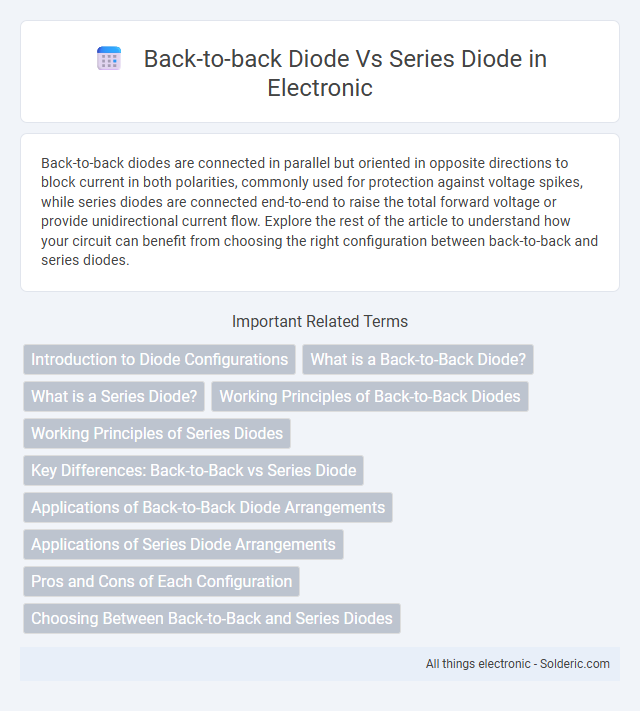Back-to-back diodes are connected in parallel but oriented in opposite directions to block current in both polarities, commonly used for protection against voltage spikes, while series diodes are connected end-to-end to raise the total forward voltage or provide unidirectional current flow. Explore the rest of the article to understand how your circuit can benefit from choosing the right configuration between back-to-back and series diodes.
Comparison Table
| Feature | Back-to-back Diode | Series Diode |
|---|---|---|
| Configuration | Two diodes connected cathode-to-cathode or anode-to-anode | Two or more diodes connected end-to-end in the same direction |
| Primary Use | Bidirectional voltage blocking and transient suppression | Increase voltage rating or current handling |
| Voltage Blocking | Blocks voltage in both directions | Blocks voltage in one direction only |
| Application Example | EMI/RFI noise suppression, AC signals protection | High voltage rectification, power supply circuits |
| Signal Behavior | Allows current flow in both directions during forward bias | Allows current flow only in one specified direction |
| Complexity | More complex due to dual orientation | Simple and straightforward |
| Common Components | Zener diodes or regular diodes paired | Standard diodes in series |
| Advantages | Bidirectional protection, improved transient suppression | Higher voltage capacity, easy scalability |
| Disadvantages | Increased complexity and power dissipation | Limited to unidirectional blocking |
Introduction to Diode Configurations
Back-to-back diode configurations connect two diodes in reverse polarity to block voltage in both directions, enhancing protection against transient voltage spikes. Series diode arrangements align multiple diodes end-to-end, increasing the overall voltage rating and ensuring current flows in one direction only. Choosing the right diode configuration impacts Your circuit's efficiency and protection depending on voltage and current requirements.
What is a Back-to-Back Diode?
A back-to-back diode configuration consists of two diodes connected in opposite directions, allowing current to block in both forward and reverse polarities while protecting circuits from voltage spikes and noise. Unlike series diodes that only allow current flow in one direction, back-to-back diodes provide symmetric voltage clamping in AC or bidirectional signal applications. This setup is commonly used in overvoltage protection and signal isolation to safeguard sensitive electronic components.
What is a Series Diode?
A series diode is an electrical component connected in a sequential chain within a circuit to control current flow and increase voltage handling capability. It allows current to pass in one direction while blocking reverse current, protecting sensitive components from voltage spikes. Series diode arrangements are commonly used in power supplies and rectifier circuits to ensure proper voltage regulation and circuit stability.
Working Principles of Back-to-Back Diodes
Back-to-back diodes consist of two diodes connected in reverse parallel, allowing current to flow in both directions while blocking voltage spikes, enhancing circuit protection. This configuration is commonly used in applications like ESD (electrostatic discharge) protection and AC signal clamping, as it effectively clamps voltage transients from both polarities. Unlike series diodes which only allow current flow in one direction, back-to-back diodes provide bidirectional clipping, making them ideal for safeguarding sensitive components against voltage surges.
Working Principles of Series Diodes
Series diodes are connected end-to-end so that the current flows sequentially through each diode, allowing them to share voltage and provide high voltage blocking capabilities. Each diode in the series must withstand the reverse voltage when the circuit is off, and the total voltage rating is the sum of individual diodes' ratings. This configuration improves voltage handling without increasing current capacity, making series diodes suitable for high-voltage applications requiring controlled forward conduction.
Key Differences: Back-to-Back vs Series Diode
Back-to-back diodes consist of two diodes connected in antiparallel, enabling bidirectional current blocking and protection against voltage spikes, while series diodes are arranged end-to-end to handle higher voltage levels by summing their breakdown voltages. Your choice between back-to-back and series diodes depends on the requirement for either bidirectional protection or increased voltage handling in circuits. Back-to-back configurations are ideal for AC applications, whereas series diodes are suited for DC circuits needing elevated voltage endurance.
Applications of Back-to-Back Diode Arrangements
Back-to-back diode arrangements are commonly used in applications requiring bidirectional voltage blocking, such as in AC voltage protection circuits and relay coil flyback protection. These configurations help prevent reverse voltage spikes and protect sensitive electronic components by allowing current flow in both directions only under specific conditions. Your circuits benefit from improved reliability and enhanced surge suppression when employing back-to-back diode setups compared to standard series diode connections.
Applications of Series Diode Arrangements
Series diode arrangements are primarily used in high-voltage applications where voltage ratings of individual diodes need to be combined to withstand larger voltage stresses, such as in power rectifiers, voltage multipliers, and surge protection circuits. These configurations ensure reliable operation in industrial equipment, electric vehicles, and renewable energy systems by preventing voltage breakdown and balancing voltage distribution across diodes. You benefit from enhanced durability and improved performance when using series diode arrangements in circuits requiring high-voltage management.
Pros and Cons of Each Configuration
Back-to-back diode configuration provides excellent protection against voltage spikes and reverse polarity, making it ideal for sensitive electronic circuits, but it introduces higher forward voltage drop and potential power dissipation. Series diode configuration offers a straightforward implementation with lower voltage drop and improved current handling, but it lacks effective protection against reverse voltage and can be less reliable in transient conditions. Choosing between them depends on the balance between protection requirements and efficiency in specific applications.
Choosing Between Back-to-Back and Series Diodes
Choosing between back-to-back and series diodes depends on the specific circuit requirements such as voltage rating, current handling, and protection needs. Back-to-back diodes provide bidirectional blocking and are ideal for AC signal protection, while series diodes increase voltage tolerance and ensure unidirectional current flow in DC applications. Assessing factors like reverse voltage stress and desired signal polarity is critical for optimal diode configuration.
Back-to-back diode vs Series diode Infographic

 solderic.com
solderic.com